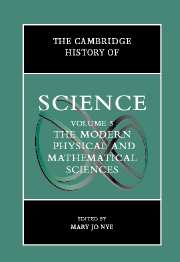Book contents
- Frontmatter
- Introduction: The Modern Physical and Mathematical Sciences
- Part I The Public Cultures of the Physical Sciences After 1800
- Part II Discipline Building in the Sciences: Places, Instruments, Communication
- Part III Chemistry and Physics: Problems Through the Early 1900s
- Part IV Atomic and Molecular Sciences in the Twentieth Century
- 17 Quantum Theory and Atomic Structure, 1900–1927
- 18 Radioactiviy and Nuclerar Physics
- 19 Quantum Field Theory: From QED to the Standard Model
- 20 Chemical Physics and Quantum Chemistry in the Twentieth Century
- 21 Plasmas and Solid-State Science
- 22 Macromolecules: Their Structures and Functions
- Part V Mathematics, Astronomy, and Cosmology Since the Eighteenth Century
- Part VI Problems and Promises at the End of the Twentieth Century
- Index
- References
19 - Quantum Field Theory: From QED to the Standard Model
from Part IV - Atomic and Molecular Sciences in the Twentieth Century
Published online by Cambridge University Press: 28 March 2008
- Frontmatter
- Introduction: The Modern Physical and Mathematical Sciences
- Part I The Public Cultures of the Physical Sciences After 1800
- Part II Discipline Building in the Sciences: Places, Instruments, Communication
- Part III Chemistry and Physics: Problems Through the Early 1900s
- Part IV Atomic and Molecular Sciences in the Twentieth Century
- 17 Quantum Theory and Atomic Structure, 1900–1927
- 18 Radioactiviy and Nuclerar Physics
- 19 Quantum Field Theory: From QED to the Standard Model
- 20 Chemical Physics and Quantum Chemistry in the Twentieth Century
- 21 Plasmas and Solid-State Science
- 22 Macromolecules: Their Structures and Functions
- Part V Mathematics, Astronomy, and Cosmology Since the Eighteenth Century
- Part VI Problems and Promises at the End of the Twentieth Century
- Index
- References
Summary
Until the 1980s, it was usual to tell the story of the developments in physics during the twentieth century as “inward bound” – from atoms, to nuclei and electrons, to nucleons and mesons, and then to quarks – and to focus on conceptual advances. The typical exposition was a narrative beginning with Max Planck (1858–1947) and the quantum hypothesis and Albert Einstein (1879–1955) and the special theory of relativity, and culminating with the formulation of the standard model of the electroweak and strong interactions during the 1970s. Theoretical understanding took pride of place, and commitment to reductionism and unification was seen as the most important factor in explaining the success of the program. The Kuhnian model of the growth of scientific knowledge, with its revolutionary paradigm shifts, buttressed the primacy of theory and the view that experimentation and instrumentation were subordinate to and entrained by theory.
The situation changed after Ian Hacking, Peter Galison, Bruno Latour, Simon Schaffer, and other historians, philosophers, and sociologists of science reanalyzed and reassessed the practices and roles of experimentation. It has become clear that accounting for the growth of knowledge in the physical sciences during the twentieth century is a complex story. Advances in physics were driven and secured by a host of factors, including contingent ones. Furthermore, it is often difficult to separate the social, sociological, and political factors from the technical and intellectual ones.
- Type
- Chapter
- Information
- The Cambridge History of Science , pp. 375 - 393Publisher: Cambridge University PressPrint publication year: 2002



